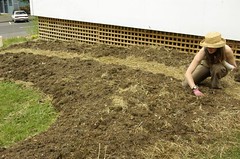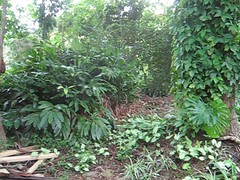| No dig garden (Photo credit: Samuel Mann) |
It doesn't even matter, really, which basic soil you start with. Because you don't actually garden in the existing soil that's already there, but instead you create raised beds for your plants by placing layers of mulch and other organic substances on top of it, which will naturally integrate with the underlying soil without you having to do anything. The mulch, in a layer 2-6 inches deep, consists of things like organic compost, leaf mold, and manure. This provides a very rich environment for worms, insects, and microbes that make a quick job of working through the mix to create a natural biosphere. With the balance of this small ecological system being more natural than in many other types of gardens, proponents of the no-dig system claim that their gardens are more free of harmful pests and plant diseases. As these organic substances decompose, they essentially compost on the spot, while simultaneously feeding your plants.
A slightly more systematic method of no-dig gardening involves more obvious layers of different types of materials, so this way of doing things is also occasionally referred to as "lasagna gardening." This may start with setting out layers of wet cardboard or newspaper on the surface, to prevent weed roots in the base soil from sprouting and intruding into the new, healthier garden. Wet straw may be spread on top of this, as the basic mulch, followed by a layer of compost, leaf mold, and manure. Then another layer of straw, all of which is wetted down thoroughly.
| No-Dig garden 2010 (Photo credit: Pip_Wilson) |
A seed ball was one of the things also advocated by Fukuoka Masanobu. These are created by taking three parts compost and five parts red (terracotta) clay, adding some manure, and forming a small ball. Into this the gardener places two or three seeds, and the balls are then set in the scoops of soil on top of the mulch. These balls allow seeds to germinate and grow even in thin soils, so in a rich, composting location like a no-dig garden, they can simply thrive.
This is a very different type of organic garden from what we normally think of when we hear that term. But it's just one more way of creating a garden that works along with nature's methods, rather than against them. If you have inhospitable soil, or just don't want to go to all the work of digging up, turning, and integrating organic matter into your existing soil, the no-dig method may be a good one for you to try. See below for some helpful resources.
Learn More About No-Dig Organic Gardening:



No comments:
Post a Comment